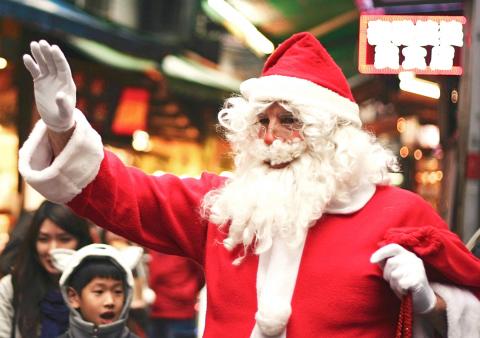The road to recovery has been slow for the Aboriginal residents of Wulai (烏來) in New Taipei City, many of whom have been affected by the typhoons earlier this year. But this Sunday, Santa will be spreading some holiday cheer to the town’s youngest residents, handing out toys and donated school supplies, as well as leading a group of pint-sized carolers.
The idea behind “Christmas in Wulai” started in 2011 with long-time Taipei expat Gary Smoke. As a Vietnam War veteran, Smoke says he’s seen what people are capable of doing to each other and wanted to contribute something meaningful to the community he was living in for a change. At the time, Smoke was also collecting instructional books recycled by English teachers in Taiwan who left their jobs when he met Tony Coolidge (he’s also a contributor for the Taipei Times). Coolidge was born in Wulai to an Atayal Aboriginal mother and American serviceman father and had just returned to Taiwan to rediscover his roots. Like Smoke, Coolidge also felt compelled to give back to the community.
“I said, ‘hey, why don’t we put on a Christmas show up in Wulai?’” Smoke says. “The rest is history.”

Photo courtesy of Maciej Korbas
Smoke now serves as the international relations director at Coolidge’s Taiwan-based non-profit organization, Atayal, which aims to connect indigenous people around the world. In the past, they’ve arranged for musicians, storytellers and children’s choirs from nearby churches to perform outside of Wulai Atayal Museum, and this year’s event will be just as boisterous.
“I’ll walk down the streets in my Santa suit handing out candy and people will stop and hand me their babies, asking me to pose so that they can get a picture of Santa with their baby,” Smoke tells me.
Santa and his helpers will hand out Christmas bells and clappers to children, encouraging them to dance. Although some might initially be too shy to join in, most eventually come around.
“Once people know Santa is here, the crowd is just in frenzy mode,” Smoke adds.
Besides organizing the yearly Christmas event, Smoke is trying to implement new programs in Wulai that will have more long-lasting change. One idea is to do a walking tour of Wulai led by a local Atayal guide and accompanied by an English translator. Another is to develop the library in the museum by donating his English textbooks and converting the place into a learning center. Finally, Smoke also wishes to start a soccer tournament in Wulai that will bring together Atayal children and students from international schools.
Smoke says that all the projects are intertwined and have to do with children of different backgrounds coming together and learning from one another. In particular, the idea to host soccer tournaments came from the English-language basketball camps Coolidge had been organizing for children in Tainan.
“Our expectations are high and it’s all contingent on collaborating with Wulai’s Atayal community,” Smoke says.

This month the government ordered a one-year block of Xiaohongshu (小紅書) or Rednote, a Chinese social media platform with more than 3 million users in Taiwan. The government pointed to widespread fraud activity on the platform, along with cybersecurity failures. Officials said that they had reached out to the company and asked it to change. However, they received no response. The pro-China parties, the Chinese Nationalist Party (KMT) and Taiwan People’s Party (TPP), immediately swung into action, denouncing the ban as an attack on free speech. This “free speech” claim was then echoed by the People’s Republic of China (PRC),

Exceptions to the rule are sometimes revealing. For a brief few years, there was an emerging ideological split between the Democratic Progressive Party (DPP) and Chinese Nationalist Party (KMT) that appeared to be pushing the DPP in a direction that would be considered more liberal, and the KMT more conservative. In the previous column, “The KMT-DPP’s bureaucrat-led developmental state” (Dec. 11, page 12), we examined how Taiwan’s democratic system developed, and how both the two main parties largely accepted a similar consensus on how Taiwan should be run domestically and did not split along the left-right lines more familiar in

Most heroes are remembered for the battles they fought. Taiwan’s Black Bat Squadron is remembered for flying into Chinese airspace 838 times between 1953 and 1967, and for the 148 men whose sacrifice bought the intelligence that kept Taiwan secure. Two-thirds of the squadron died carrying out missions most people wouldn’t learn about for another 40 years. The squadron lost 15 aircraft and 148 crew members over those 14 years, making it the deadliest unit in Taiwan’s military history by casualty rate. They flew at night, often at low altitudes, straight into some of the most heavily defended airspace in Asia.

Many people in Taiwan first learned about universal basic income (UBI) — the idea that the government should provide regular, no-strings-attached payments to each citizen — in 2019. While seeking the Democratic nomination for the 2020 US presidential election, Andrew Yang, a politician of Taiwanese descent, said that, if elected, he’d institute a UBI of US$1,000 per month to “get the economic boot off of people’s throats, allowing them to lift their heads up, breathe, and get excited for the future.” His campaign petered out, but the concept of UBI hasn’t gone away. Throughout the industrialized world, there are fears that